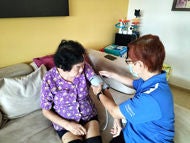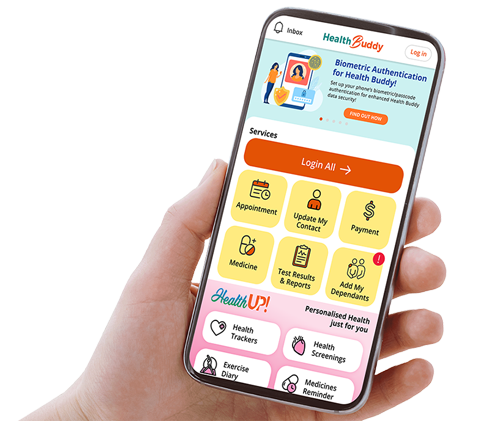What is - Childhood Cataract
Cataracts occur when the natural lens in our eyes becomes cloudy.

While we hear of cataracts in elderly seniors, they can occur in children as well. But childhood cataracts are rare, occurring in up to 15 per 10,000 children.
Symptoms of Childhood Cataract
As the lens focuses light entering our eye, clouding of the lens in cataracts can result in blurred vision or glare.
It may be difficult for young children to communicate that they have blurred vision. Some telling signs include excessive blinking and eye rubbing, squinting, covering one eye, tilting their heads or going up close to objects.
Childhood Cataract - Causes and Risk Factors
Childhood cataracts can occur from birth or develop later in childhood/adolescence. They can occur in isolation with no known cause.
These cataracts can also be associated with other health problems—such as certain genetic syndromes or infections within the womb during pregnancy.
Childhood cataracts may also develop following injury to the eye or medications (e.g. excessive steroid use).
Diagnosis of Childhood Cataract
When a child is diagnosed with cataracts, it is important for the doctor to determine:
- Cause of the cataract: Further tests may be needed—including imaging, blood and urine test, or genetic tests.
- How the cataract affects the child's vision: This depends on the location and extent of the cataract, which affects how urgently the cataract needs to be removed by surgery
- Whether the child has
other eye abnormalities or
other health problems (e.g. affecting the brain, heart etc): These will affect treatment choice and patient's outcome.
Treatment for Childhood Cataract
The choice of treatment depends on how severe the cataracts are and how much they are affecting the child's vision.
In children with mild cataracts, surgery might not be required and treatment may include glasses, eye patching (of the normal eye, to prevent lazy eye in the eye with cataract) or eye drops.
However, if the cataract affects the child's vision, then surgery is required.
- Infants with very thick cataracts from birth may need to have surgery when 2 or 3 months old.
- In older children, timing of surgery depends on the duration and type of cataracts, but usually early treatment is recommended to prevent lazy eye.
- If cataract is diagnosed very late (>9 years old), when lazy eye has already occurred, then vision is sometimes unrecoverable.
Surgery involves the removal of the cataract to allow for clear vision.
In very young children (<2 years old), it may not be possible to insert a lens implant, and they may require either special (aphakic) glasses or contact lenses to see clearly.
In older children, a man-made lens implant may be inserted in the eye at time of surgery. Having an implanted lens means that they may only require regular powered glasses rather than high-powered thick aphakic glasses.
After the surgery, the child will be watched closely for problems such as infection and increased eye pressure. Subsequently, long-term care includes monitoring the development of the child's vision (Eg. with glasses, contact lenses, patching as required), other problems like increased eye pressure, posterior capsular opacification (cloudy film behind lens implant after surgery that can cause cloudy vision) and retinal detachment.
However, it is possible for a cloudy film to grow on the bag (lens capsule) and cause your vision to be more cloudy. This is called posterior capsule opacification (PCO), which may occur months or years after surgery. It can be cleared with a 5 minute, painless laser treatment (YAG Capsulotomy) that is done in the clinic.
Case Examples
Example 1:


Infant A was found to have a white reflex or ‘white eye’ (white-colored reflection of the eye is seen when light is shone on the eye; as compared to reddish pink-colored reflection normally) in his right eye during his visit to the doctor. The doctor found a white cataract on his eye check, which was affecting his vision.
He went for surgery to remove the white cataract at 3 months old. After the operation, he was fitted with contact lens for his right eye. His mother diligently ensured to put on the right eye contact lens every day and patched his left eye (the other normal eye) 4-6 hours per day, to encourage the development of his right eye’s vision.
At 12 years old, his vision was 6/6 in his left eye (normal vision) and 6/9 in the right eye (2 lines on Snellen’s chart from normal vision). Fortunately, he did not have any problems such as glaucoma (high eye pressure), retinal detachment and amblyopia (lazy eye due to poor development of the right eye’s vision). At 13 years old, a man-made lens implant was placed in his right eye, so that he does not need to wear contact lens anymore.
Example 2:

Child B had poor vision (6/36 on Snellen’s chart) during her Kindergarten year 1 eye screening. Her doctor found lamellar cataracts (a form of cataracts in children) in both eyes. There were no other eye or general health problems found.
Outcomes at SNEC
Contributed by
The information provided is not intended as medical advice. Terms of use. Information provided by SingHealth.
Get to know our doctors at SingHealth Hospitals in Singapore.
Get to know our doctors at SingHealth Hospitals in Singapore. here.




















